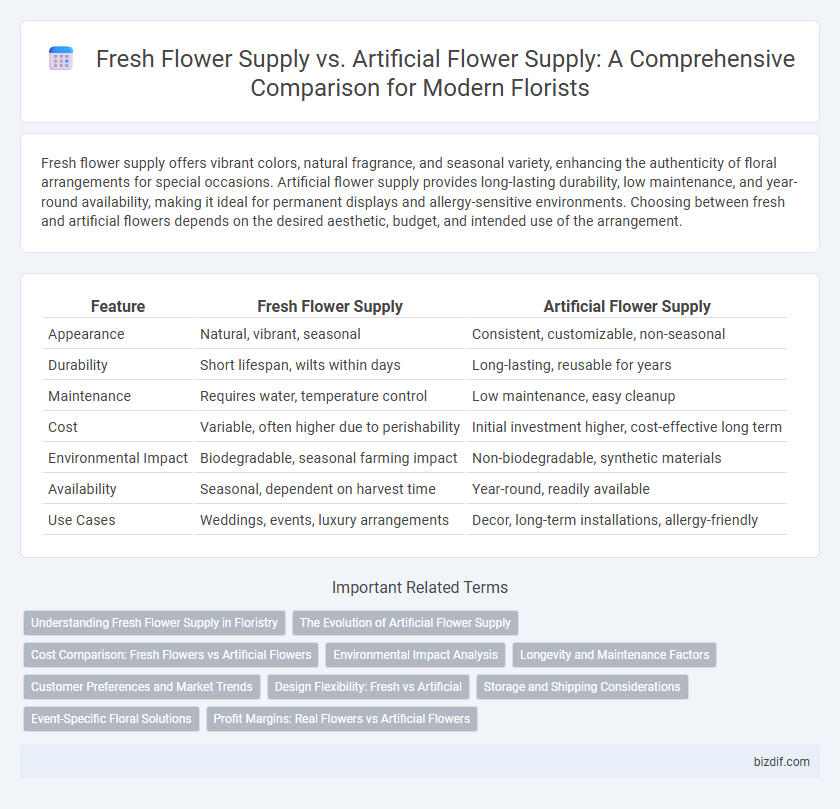Fresh flower supply offers vibrant colors, natural fragrance, and seasonal variety, enhancing the authenticity of floral arrangements for special occasions. Artificial flower supply provides long-lasting durability, low maintenance, and year-round availability, making it ideal for permanent displays and allergy-sensitive environments. Choosing between fresh and artificial flowers depends on the desired aesthetic, budget, and intended use of the arrangement.
Table of Comparison
| Feature | Fresh Flower Supply | Artificial Flower Supply |
|---|---|---|
| Appearance | Natural, vibrant, seasonal | Consistent, customizable, non-seasonal |
| Durability | Short lifespan, wilts within days | Long-lasting, reusable for years |
| Maintenance | Requires water, temperature control | Low maintenance, easy cleanup |
| Cost | Variable, often higher due to perishability | Initial investment higher, cost-effective long term |
| Environmental Impact | Biodegradable, seasonal farming impact | Non-biodegradable, synthetic materials |
| Availability | Seasonal, dependent on harvest time | Year-round, readily available |
| Use Cases | Weddings, events, luxury arrangements | Decor, long-term installations, allergy-friendly |
Understanding Fresh Flower Supply in Floristry
Fresh flower supply in floristry relies on timely harvesting, careful handling, and rapid distribution to maintain optimal freshness and vibrant appearance, crucial for customer satisfaction. Seasonal availability and regional sourcing significantly impact the variety and quality of blooms, influencing design possibilities and pricing. Proper storage conditions, such as controlled temperature and humidity, play a vital role in extending the lifespan of fresh flowers and preserving their natural fragrance and texture.
The Evolution of Artificial Flower Supply
The evolution of artificial flower supply has significantly transformed the floristry industry by providing durable, allergen-free alternatives to fresh flowers. Advances in materials such as high-quality silk and realistic polymers have enhanced the visual appeal and longevity of artificial blooms. These innovations address the limitations of fresh flower supply, including perishability and seasonal availability, enabling florists to offer versatile and sustainable arrangements year-round.
Cost Comparison: Fresh Flowers vs Artificial Flowers
Fresh flower supply typically incurs higher costs due to seasonal availability, transportation, and perishability, leading to frequent repurchasing. Artificial flowers require a larger initial investment but offer long-term savings as they are reusable and maintenance-free. Evaluating cost-effectiveness depends on event duration and floral arrangement usage frequency, with artificial options being more economical for permanent displays.
Environmental Impact Analysis
Fresh flower supply contributes to significant water consumption and pesticide use, impacting ecosystems and increasing carbon emissions through transportation and refrigeration. Artificial flowers, often made from non-biodegradable plastics and synthetic materials, pose long-term environmental hazards due to their production processes and landfill accumulation. Evaluating the full lifecycle, fresh flowers tend to have a smaller carbon footprint when sourced locally, whereas artificial flowers create persistent waste and resource depletion concerns.
Longevity and Maintenance Factors
Fresh flower supply offers natural beauty with a limited lifespan of typically 5 to 10 days, requiring regular water changes and temperature control to maintain freshness. Artificial flower supply provides durability lasting years without wilting, reducing maintenance to occasional dusting and cleaning. Prioritizing longevity and low upkeep makes artificial flowers ideal for long-term displays, while fresh flowers excel in occasions demanding natural fragrance and aesthetic vibrancy.
Customer Preferences and Market Trends
Customer preferences in floristry increasingly favor fresh flower supply due to their natural fragrance, vibrant colors, and symbolic value in celebrations, driving higher demand in retail and event markets. Market trends reveal a growing niche for artificial flower supply, especially in regions prioritizing durability, allergen-free options, and cost-effectiveness for long-term decor solutions. Analysis of sales data indicates fresh flowers dominate seasonal peaks, while artificial flowers maintain steady year-round demand, reflecting diverse consumer needs and evolving purchasing behaviors.
Design Flexibility: Fresh vs Artificial
Fresh flower supply offers unparalleled design flexibility through a wide range of natural colors, textures, and fragrances that can be combined to create unique, seasonal arrangements. Artificial flower supply provides consistent availability and durability, allowing designers to experiment with shapes and colors year-round without concerns about wilting or allergies. Selecting between fresh and artificial flowers depends on the desired aesthetic, longevity, and environmental conditions of the floral design.
Storage and Shipping Considerations
Fresh flower supply requires refrigerated storage and expedited shipping to maintain bloom freshness and prevent wilting, with typical shelf life ranging from 3 to 14 days depending on flower type. Artificial flower supply offers greater flexibility, as items can be stored at ambient temperature and shipped via standard carriers without risk of damage from temperature fluctuations. Efficient logistics for fresh flowers often involve cold chain management, while artificial flowers allow bulk storage and longer inventory turnover without quality degradation.
Event-Specific Floral Solutions
Fresh flower supply offers vibrant, fragrant blooms that enhance event ambiance with natural beauty, making them ideal for weddings and upscale gatherings. Artificial flower supply provides durable, reusable arrangements perfect for long-term displays and cost-effective event decor. Event planners often balance fresh and artificial options to customize floral solutions that meet specific aesthetic and budgetary requirements.
Profit Margins: Real Flowers vs Artificial Flowers
Fresh flower supply offers higher profit margins due to premium pricing driven by their natural beauty and perishability, which creates frequent repeat sales and strong demand. Artificial flower supply benefits from lower overhead costs and extended shelf life, allowing for bulk purchases and stable inventory, but typically commands lower prices and profit percentages. Businesses balancing fresh and artificial flowers often maximize profitability by leveraging the high turnover of fresh blooms alongside the longevity and cost-efficiency of artificial alternatives.
Fresh Flower Supply vs Artificial Flower Supply Infographic

 bizdif.com
bizdif.com